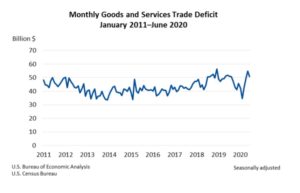- The U.S. dollar has been in a downtrend that looks likely to continue.
- The Fed has fueled further speculation thanks to its recent policy changes.
- With no real competitor for a global currency, the dollar won’t go away overnight.
The U.S. dollar appears set for a decade-long downward trend, at least according to some analysts. While it’s true that the outlook for the buck doesn’t look good right now, there are some advantages to a weaker dollar.
Dollar Set to Drop Until the Fed Changes Course
The most recent slide in the buck took place after the Federal Reserve announced last week that they’re changing their policy regarding interest rates. Rather than focus strictly on inflationary measures, they’ll focus more on the labor market, ensuring higher employment takes precedence over sticking to a 2% inflation rate.
That’s a move that many see as a sign that the Fed will take years (if ever) to start raising interest rates again, given how long labor markets typically recover from a recession. The most recent recession has been particularly hard on jobs, given the massive number of shutdowns involved. That’s helped the dollar slide to nearly two-year lows.
While the dollar may move down, it doesn’t do so in a vacuum. For the dollar to fall, other currencies have to rise in relative value. And with other major industrial nations pursuing similar policies right now, it’s not clear that the recent dollar decline will play out over the next decade at all.
Weaker Currency? Stronger Exports and Asset Prices
Simple economics tells us there are some advantages to a weaker currency, which could help spur an economic recovery.
The first place is in exports. A weaker dollar makes U.S. exports more attractive globally compared to the domestic goods of other markets.

While that’s yet to show up in U.S. export levels lately, a modest change there could be beneficial to domestic producers of exports. And since most Americans use the dollar exclusively, the weakening greenback globally will have a muted impact at home.
Where there will be an impact is in areas we’ve already seen: asset markets. Home prices have held up well this year as workers have had to hunker down. The stock market recovered from the fastest drop to a bear market in history with the fastest rally in history. Commodity prices are on the rise as well.
While a weaker dollar will spur speculation that other countries may abandon the dollar for international trade, that’s unlikely to occur overnight. There has been a gradual shift over the past decade for increased bilateral trade agreements between countries bypassing the dollar. But in a crisis, investors who want cash want dollars.
No other currency has the right combination of scope and stability. Smaller currencies that have been used as hedges, like the Swiss franc, simply don’t circulate enough globally to replace the buck.
China, seen as a rising threat to the dollar’s hegemony, has been tremendously set back following the pandemic outbreak this year, and the impact it will have on the country’s global manufacturing dominance.
All told, investors should expect a weaker dollar, and possibly higher inflation, to gradually unfold over the next few years. That also explains the surge into gold and bitcoin, which represents a move away from all government-created currencies, and why it may likely continue.
Disclaimer: This article represents the author’s opinion and should not be considered investment or trading advice from CCN.com. Unless otherwise noted, the author has no position in any of the stocks mentioned.




